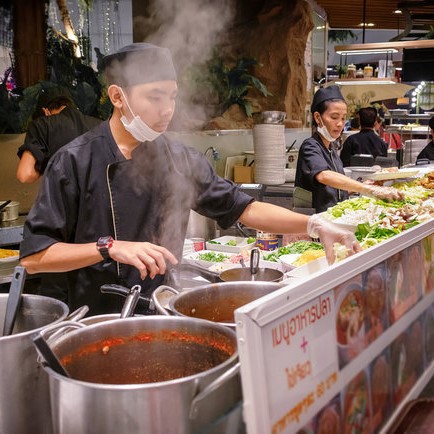How to Start Filing Tax Documents after Opening a Restaurant
Accounting and taxes are like bitter medicine for entrepreneurs, because many think they are difficult to deal with but necessary and unavoidable. As a result, one of the most frequently asked questions by restaurateurs is about accounting and taxes.
Figuring out what taxes restaurateurs have to pay and how to pay them are such serious matters that a lot of people decide to skip them first. Eventually, they have to pay more in back taxes than they the original amount they would have had to pay. For this reason, it is an important subject and, if you put some effort into it, you’ll find it’s not so hard after all. If you want to know what taxes you have to pay for a restaurant, this article contains the complete summary.
- Familiar Value-added Taxes (VAT)
- Customs Duties You May Have Overlooked
- You Have to Pay Taxes If You Hire Workers
- You Have to Pay Taxes for Renting out a Space, Too
- Value-added Taxes (VAT), Write It Down When You’re Ready
- Taxes Are at the End, What’s Important at the Beginning Is Accounting
What Taxes Do Entrepreneurs Have to Pay?
Let’s begin with the types of taxes you have to pay, starting from the restaurant’s conception to when you open for business. How many kinds of taxes are involved?
Familiar Value-added Taxes (VAT)

You should be familiar with the first one since everyone has to pay it, from individual entrepreneurs to corporations. Whenever entrepreneurs pay for anything like materials or ingredients for a restaurant, they have to pay a VAT rate of 7 percent for goods directly from the seller, except for agricultural products and raw materials for cooking; you don’t have to pay taxes for these.
The entrepreneur would have to ask for the receipts in order to calculate the taxes for each month and make an input tax report. This one is simple enough since everyone already knows about it, but what we want to remind you to always ask for and keep the receipts to enter into your accounts.
**None for agricultural products and raw materials.
Customs Duties You May Have Overlooked
Do restaurants have to pay customs duties? Don’t get confused, yet. You have to pay them if you import materials, equipment and ingredients that are on the list of taxable imported goods. As for how much you have to pay, you have to check with the Customs Department about the tariffs, because there are different rates for each product type.
You Have to Pay Withholding Tax and Rental and Labor Taxes, Too
Another tax you’re sure to encounter is the withholding tax. There are many different withholding tax rates as follows:
1% Transportation Fees
2% Advertisement Fees
3% Wages/Service Fees
5% Rental Fees
10% Dividends
15% Overseas Transfer
Withholding taxes are deducted before VAT. Most of us are familiar with the 3-percent rate, for wages and service fees, and the 5-percent rate, for rental fees. If you don’t pay for these, you’d risk having to pay a maximum fine of 2,000 baht per item.

In addition, if you have employees and you pay them an average monthly salary of over 26,000 baht, you’d have to deduct the withholding tax before filing your taxes with the Revenue Department. However, if the combined salaries do not exceed 26,000 baht per month, it can be exempt. Also, don’t forget, there’s a withholding tax for rental fees at the aforementioned rate of 5 percent.
Signboard Tax
This is another subject that, if you didn’t know, could take a toll on you. It concerns your restaurant’s sign. Some people may wonder why they have to pay more on their signboard tax than the restaurant next door, even though the restaurant next door has a bigger, grander sign than theirs. You have to look at your sign to see which language you’ve got displayed on it. If your sign only displays a foreign language, it’s a guarantee you’ll have to pay a large amount, because the law stipulates as follows:
- Signboards displaying only Thai characters are taxed at a rate of 3 baht per 500 square centimeters.
- Signboards displaying Thai characters mixed with foreign characters or images and/or other logos are taxed at a rate of 20 baht per 500 square centimeters.
- Signboards displaying no Thai characters, with or without images or logos, and signboards displaying some Thai characters or displaying Thai characters that are all under foreign characters are taxed at a rate of 40 baht per 500 square centimeters.
At any rate, if the calculated rate to be paid is under 200 baht per signboard, the tax to be paid is to be 200 baht per signboard.
Pay attention and look back at your own restaurant’s signboard and you’ll know how much you have to pay in signboard taxes or what you have to fix to reduce the taxable amount.
Land Tax or Old Building Tax

This is a new tax effective as of this year. This tax concerns the portion of land you’re renting for your restaurant. Don’t worry too much about this. Your landlord will naturally make this burden your responsibility, but our point is that this tax is still complicated and the tax rates are still uncertain. Therefore, our advice for this tax is to take it easy and follow up on the news about it closely to see if, in the last month you’re allowed by law to pay your taxes, you still have to pay it or if it’ll be postponed or if there’ll be tax reductions. So, wait until the last minute to deal with it. This land tax is the only one you don’t have to rush to pay.
Even before you open and earn income, you have so many taxes you have to pay and when you open for business and earn income, there are more taxes involved, such as personal income tax and corporate income tax.
Personal income tax has to be filed twice a year. For the first round, you have to file the PIT 94 form in September for income earned from January to June.
For the second round, you have to file the PIT 90 form in March of the following year for income earned from January to December. The amount for first round of tax payment is to be deducted from the calculated tax amount for the second round.
For corporate income tax, entrepreneurs who are liable for this tax also have to pay file it twice a year as follows:
The first round, CIT 51, is the half-yearly CIT which is to be filed within 2 months after the first 6 months of the accounting period.
The second round, CIT 50, is the CIT for the end of the accounting period which is to be filed within 150 days from the closing date of the accounting period.
Value-added Taxes (VAT), Write It Down When You’re Ready
A lot of people ask if they have to record this tax. It depends. You have to check your restaurant’s balance to see if the annual income or sales (unrelated to profit) exceeds 1.8 million baht. If you’re confident that it doesn’t exceed that amount, there’s no need to record it. However, if the sales exceed 1.8 million baht, the entrepreneur is required by law to record the value-added tax. Nonetheless, don’t forget to include the value-added tax into your sales price calculation.
When it comes to taxes, we advise you to learn more about how to file each type of tax directly from the Revenue Department. In addition, the Revenue Department currently allows for online tax filing, which is convenient. You can learn about the details on the Revenue Department’s website, click.

Taxes Are at the End, What’s Important at the Beginning Is Accounting
Taxes are a responsibility we can’t avoid, but what has a direct impact on whether we have to pay a lot, a little, right or wrong is accounting, especially income-expense accounting. Record all the information into an accounting book or table so you can know the source of every income and expense and so you can use it as evidence when you file each tax. This is very important.
Many people see taxes as a complicated subject, even though there are simple ways to deal with it. However, it’d be too long to explain it in text and you might not understand it as well as if an accounting expert were to explain it to you straightforwardly in the online course “Manage a Restaurant Yourself with Simple Accounting” that aims to help restaurateurs systematically manage income-expense accounting so they can see the profit, set up a stock system and manage the cost so they can meet profit goals. The course also includes the dos and don’ts in restaurant accounting and taxes.



